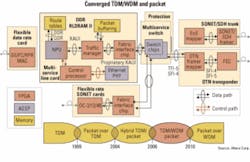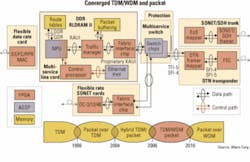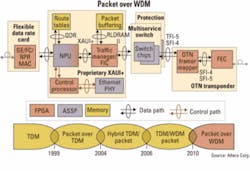FPGAs follow optical industry trends
by Meghan Fuller
The field-programmable gate array (FPGA) has evolved from its role as a prototyping vehicle in the late 1980s and early 1990s to a device that is often found in the heart of next-generation optical transport systems. In fact, to chart the trends in the FPGA market is to chart the trends in the overall optical industry, from the long haul to the access.
An FPGA is a semiconductor device comprising programmable logic components or logic blocks and programmable interfaces. “An FPGA is a basically a lookup table or multiplexer that is connected to another lookup table with some routing,” explains Amit Dhir, director of infrastructure vertical markets, including wired and wireless communications and storage and server markets, for Xilinx (www.xilinx.com).
Put in very simple terms, an FPGA is like a blank notebook; the same notebook can be given to multiple vendors who then add their own content to create a unique story. An application-specific integrated circuit (ASIC), by contrast, is usually designed by an equipment vendor’s in-house engineering team for a specific purpose, then custom-manufactured for use only by that vendor. Like an ASIC, an application-specific standard product (ASSP) is designed for a specific operation, but typically sold to a number of companies as an “off-the-shelf” device by such suppliers as AMCC, Vitesse, PMC-Sierra, etc.
Ten years ago, FPGAs were primarily used as a mechanism for testing a design before it was spun into an ASSP or an ASIC. But all sources interviewed for this story say that the economics have now shifted in favor of using FPGAs as a cornerstone of commercial products.
The processing capacity of the FPGA has grown exponentially since the device’s inception in 1984, says Dhir. And today, FPGAs feature the integration of a variety of harder blocks, including embedded memory, embedded transceivers, and sometimes even embedded IP. For $2 to $5 more, he says, many companies are choosing to design FPGAs into their systems on a permanent basis; they believe the flexibility and field upgradeability of the FPGA is worth the slight cost premium.
Martin Mason, director of silicon product marketing at Actel (www.actel.com), says it’s not unusual for his company to quote million-piece-a-year quantities for its FPGAs. “When I started in this industry 15 years ago, an order of 10,000 units a year was considered a big deal,” he recalls. “So we have grown our volumes by probably two orders of magnitude or more during that time period, which is also coincident with us dropping our prices by approximately two orders of magnitude.”
“This is not a stop-gap,” Dhir maintains. “With the evolution of the network from ATM to IP, from IPv4 to IPv6, MPLS, etc., everyone’s choices are many and different, and they cherish programmability.”
To understand where FPGAs play today, it’s important to consider the macro-trends in the overall optical transport industry. The decade between 1995 and 2005, for example, was characterized by the network evolution toward IP, MPLS, and Ethernet and away from traditional SONET/SDH traffic, notes Arun Iyengar, senior director of Altera’s communications business unit (www.altera.com).Today’s networks are increasingly moving to a converged TDM, WDM, and packet environment, characterized by the emergence of packet optical networking platforms (PONPs), which include Ethernet, SONET, and WDM technology in the same box.
In this converged environment, the FPGA can provide multiple functions, says Iyengar. Consider the flexible data rate card, he says (see Fig. 1). The FPGA can provide Gigabit Ethernet, Fibre Channel, Resilient Packet Ring (RPR), and other MAC-type functions that provide the link to the multiservice line card. Iyengar says the multiservice line card typically contains a dedicated network processing unit (NPU) to perform packet classification and other functions, but there is a trend now to use FPGAs in place of the NPU.
The NPU or FPGA on the multiservice access card then connects to the traffic manager, another semiconductor that Iyengar says can be an FPGA. Iyengar notes that in the TDM world, traffic management was not particularly important because each signal had its own time slot. “But as you move into the packet world, traffic shaping, traffic policing, and traffic QoS become very critical,” he says. FPGAs also can be used as the fabric interface chip, which enables the multiservice line card to communicate with other system cards.FPGAs also can be found in the SONET/SDH trunk cards or OTN transponder, performing such functions as Ethernet over SONET mapping, SONET/SDH framing, OTN framing/mapping, and forward error correction (FEC) if ASSPs can’t be found that meet the system designer’s requirements.
Referring to Fig. 1, Iyengar says, “The only things that are left that are not FPGA functions are things like the Ethernet PHY because you typically end up buying a Marvell or a Broadcom or someone else’s chip. And things such as route tables and packet buffering-these are memory elements. Apart from that, pretty much everything else on the cards is an FPGA play,” he says. Iyengar is quick to note that these are not future FPGA plays either; customers are using FPGAs for all of the above functions in their boxes today.
From 2012 and beyond, says Iyengar, industry insiders are predicting a long-term trend to bring Ethernet into the core and long-haul networks. In this case, he says, Ethernet over WDM will be used for packet transport and IP/MPLS/Ethernet will be used for data transport. Though it has yet to be determined whether ASICs, ASSPs, or FPGAs will take the lion’s share of these pure packet-over-WDM networks of the future, Iyengar believes FPGAs are “very well positioned to take that on.” FPGAs could perform the Gigabit Ethernet/Fibre Channel/RPR MAC functions, as well as the traffic manager functions (see Fig. 2). Packet-over-WDM likely will use enhanced FEC, designed with “different mechanisms to make sure that you can use the optical bandwidth to its fullest extent,” says Iyengar. Again, an FPGA could handle this enhanced FEC function as well.
Also on the horizon is high-speed transmission, a macro-trend both within the FPGA space and the optical industry at large. “Our customers are actually talking about and entertaining 40-gig systems, which they were not talking about before,” confirms Xilinx’s Dhir. “And things like 100-Gigabit Ethernet [100GbE] are starting to come up for the long haul.” He claims that 40-Gbit/sec DWDM, which uses extended FEC, is “pretty much on the minds of the top six or seven vendors right now.” FPGAs can perform this extended FEC as well as the OC-768 framer/mapper functions, says Dhir.
Iyengar confirms that Altera’s customers are also very interested in 100GbE. But at 100GbE, he says, “to even touch the packet and do something with it, you need to have at least 4× of processing bandwidth on your chip. That capability doesn’t exist today, which is why we don’t have 100-gig boxes yet. But we’re fast approaching where we can support that,” he contends.
On the access side, Dhir reports that the first-generation GPON designs were all done in FPGAs, both the optical line terminal (OLT) and the optical network terminal (ONT). He says Xilinx does both the GPON PHY and the GPON MAC functions.
Iyengar agrees that FPGAs have a strong play in what he calls multiservice access nodes, which includes GPON as well as DSL/DSLAM architectures. He says Altera’s FPGAs support 1-Gbit/sec processing for DSL-type line cards all the way to an eight-port GPON OLT that requires more than 20 Gbits/sec of processing bandwidth. On the OLT, he says, FPGAs provide two basic functions: They can do the transceiver-based interface to the front end and the packet processing.
According to Dhir, the emergence of video-IPTV, mobile TV, and video conferencing-is also a big trend in the FPGA space. “How do you compress video, encrypt it, and transport it across networks?” he muses. “This is a huge space for the FPGA. It is new and upcoming in the sense that while GPON plays into getting data, voice, and video to your house, there are other portions of the network that have not transitioned completely,” he says. “So the metro is changing to accommodate that as well because predominantly over the last few years, it’s been a voice and data game, not a video game.”
Meghan Fuller is senior editor at Lightwave.


